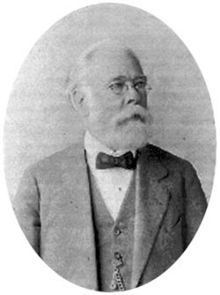Hermann von Ihering
Hermann von Ihering | |
|---|---|
Gießen, Germany | |
| Nationality | German |
| Known for | Zoology |
Hermann Friedrich Albert von Ihering (9 October 1850 – 24 February 1930) was a
Biography

Hermann Friedrich Albert von Ihering was born in 1850 in Kiel, Germany, the oldest son of Rudolf von Jhering.[1]
Under the advice of
On 26 April 1880, Ihering married a widow, Anna Maria Clara Wolff (born von Bezel), who had a 10-year-old boy, Sebastian Wolff, from her first marriage. The marriage was not approved by Ihering's family and, as a result, he travelled to Brazil soon after.
In 1883, Ihering was nominated travelling naturalist of the National Museum of Rio de Janeiro and lived in several cities by the Lagoa dos Patos. He eventually bought an island at the delta of the Camaquã River, which started to be called Ilha do Doutor (Doctor's Island) and lived there for some years. He was naturalized Brazilian in 1885.[1]
Between 1893 and 1894, Ihering helped to found the
In 1901, his son Rodolpho was sent to Europe to study in Heidelberg. However, his other son, Wilhelm, died soon after, being only 16 years old, and his wife Anna became too shaken by the event and died later in the same year. Rodolpho then abandoned his studies and returned to Brazil to help his father.[1]
During a trip to Europe to visit some colleagues in 1907, Ihering met again his first love, Meta Buff, from Gießen, and married her that same year. Later, during World War I, he was accused of nepotism and of selling to the state a stone that was donated to the Museu Paulista. This forced him to leave his job as director of the museum in 1916.[1] He returned to southern Brazil and continued his studies in Santa Catarina, and in 1918 he was invited to occupy the chair of zoology at the University of Córdoba, Argentina. However, he refused the offer and remained in Brazil in order to organize a small museum in Florianópolis. One year after the museum opened, the government reduced his wage to one third, and three months later it was announced that he would not be paid anymore for his job.[1]
In 1920, Ihering returned to Europe, living first in
Homage
Several species were named in honor of Ihering, including the following.
- Anisolepis iheringii Boulenger, 1885 (lizard), type species of the genus Anisolepis Boulenger, 1885, but a junior synonym of Anisolepis undulatus (Wiegmann, 1834)[2]
- Brucepattersonius iheringi (Thomas, 1896) (rodent)
- Cetopsorhamdia iheringi Schubart & Gomes, 1959 (catfish)
- Choeradoplana iheringi Graff, 1899 (land planarian)
- Enyalius iheringii Boulenger 1885 (lizard)[2]
- Fusconaia iheringi Wright 1898 (freshwater mussel)
- Gastrocopta iheringi (Suter, 1900) (gastropod)
- Keyserling, 1891 (tarantula)
- Snethlage, 1914 (antbird)
- Phyllomedusa iheringii Boulenger, 1885 (frog)[3]
- Trinomys iheringi (Thomas, 1911) (Ihering's Atlantic spiny rat)
- Unionicola iheringi (Koenike, 1890) (water mite)
The peer-reviewed scientific journal Iheringia was also named after him.[4]
Bibliography
His bibliography include 310 works; 20 of these works are about birds.[5]
He was the author of Catálogos da Fauna Brasileira (1907) with his son Rudolpho von Ihering.
- (1877). Vergleichende Anatomie des Nervensystemes und Phylogenie der Mollusken. Leipzig: Engelmann. x + 290 pp. + Plates I-VIII. (in German).
- (1880). "Beiträge zur Kenntniss der Nudibranchien des Mittelmeeres. Part 1. (1. Chromodoris, 2. Doriopsis, 3. Cadlina.)" Malakozoologische Blätter N.F. 2: 57-112. (in German).
- (1886). "Zur kenntnis der Nudibranchien der brasilianischen kuste. Jahrbücher der Deutschen ". Malakozoologischen Gesellschaft 13 (3): 223–240. (in German).
- (1886). "Beiträge zur Kenntniss der Nudibranchien des Mittelmeeres, Part 2. 4. Die Polyceraden ". Malakozoologische Blätter N.F. 8: 12–48. (in German).
- (1904). The Anthropology of the state of S. Paulo, Brazil.
- (1922). Phylogenie und System der Mollusken. (in German).
See also
References
- ^
- ^ ISBN 978-1-4214-0135-5. ("Ihering, H.F.I.", p. 129).
- ISBN 978-1-907807-42-8.
- .
- JSTOR 4075531.
Further reading
- Isaia, Antônio. (2008). Os Fascinantes Caminhos da Paleontologia. Pallotti. 60 pp. (in Portuguese).
- Beltrão, Romeu (1958). Cronologia Histórica de Santa Maria e do extinto município de São Martinho. 1787–1933. Vol I. Pallotti. (in Portuguese).
External links
- Works by or about Hermann von Ihering at Internet Archive
- Ethnographic works by Hermann von Ihering at the Curt Nimuendajú Digital Library
